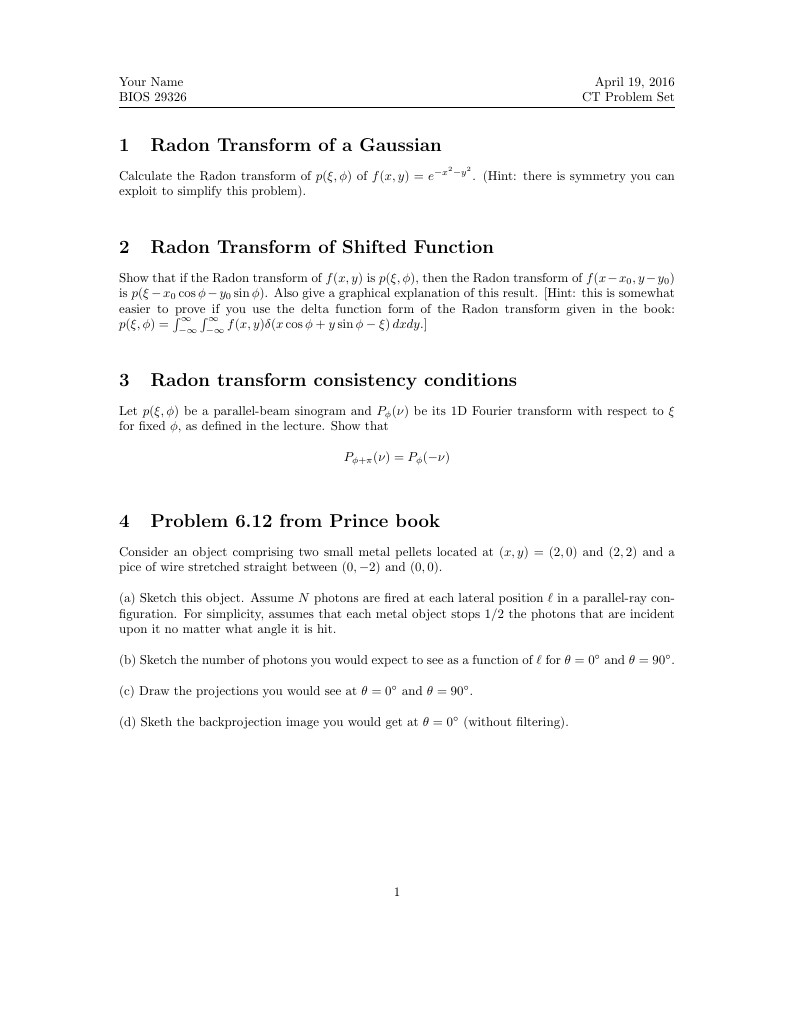
CT Problem Set
Autor:
David Rigie
Last Updated:
hace 10 años
License:
Creative Commons CC BY 4.0
Resumen:
CT problem set for undergraduate Medical Physics course.

\begin
Discover why over 20 million people worldwide trust Overleaf with their work.
CT problem set for undergraduate Medical Physics course.

\begin
Discover why over 20 million people worldwide trust Overleaf with their work.
\documentclass{article}
\usepackage{geometry}
% Make header with name and date etc.
\usepackage{fancyhdr}
\lhead{Your Name\\BIOS 29326}
\rhead{\today\\CT Problem Set}
\thispagestyle{fancy}
\usepackage[utf8]{inputenc}
\setlength{\parindent}{0pt} % Don't indent new paragraphs
\setlength{\headheight}{24pt}
\begin{document}
\section{Radon Transform of a Gaussian}
Calculate the Radon transform of $p(\xi, \phi)$ of $f(x,y) = e^{-x^2 - y^2}$. (Hint: there is symmetry you can exploit to simplify this problem).
\vspace{12pt}
% Your Answer goes here
\section{Radon Transform of Shifted Function}
Show that if the Radon transform of $f(x,y)$ is $p(\xi,\phi)$, then the Radon transform of $f(x-x_0,y-y_0)$ is $p(\xi-x_0\cos{\phi} - y_0\sin{\phi})$. Also give a graphical explanation of this result. [Hint: this is somewhat easier to prove if you use the delta function form of the Radon transform given in the book: $p(\xi,\phi) = \int_{-\infty}^\infty \int_{-\infty}^{\infty} f(x,y)\delta(x\cos{\phi} + y\sin{\phi} - \xi)\,dxdy$.]
\vspace{12pt}
% Your Answer goes here
\section{Radon transform consistency conditions}
Let $p(\xi,\phi)$ be a parallel-beam sinogram and $P_\phi(\nu)$ be its 1D Fourier transform with respect to $\xi$ for fixed $\phi$, as defined in the lecture. Show that
$$
P_{\phi + \pi}(\nu) = P_{\phi}(-\nu)
$$
\vspace{12pt}
% Your Answer goes here
\section{Problem 6.12 from Prince book}
Consider an object comprising two small metal pellets located at $(x,y) = (2,0)$ and $(2,2)$ and a pice of wire stretched straight between $(0,-2)$ and $(0,0)$.\\
(a) Sketch this object. Assume $N$ photons are fired at each lateral position $\ell$ in a parallel-ray configuration. For simplicity, assumes that each metal object stops 1/2 the photons that are incident upon it no matter what angle it is hit.\\
(b) Sketch the number of photons you would expect to see as a function of $\ell$ for $\theta = 0^\circ$ and $\theta = 90^\circ$. \\
(c) Draw the projections you would see at $\theta = 0^\circ$ and $\theta = 90^\circ$.\\
(d) Sketh the backprojection image you would get at $\theta = 0^\circ$ (without filtering).
\vspace{12pt}
% Your Answer goes here
\end{document}